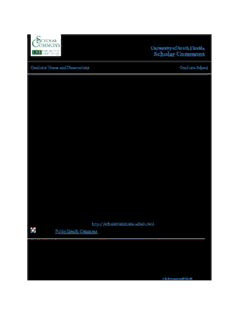
Reduction of Airborne Silica Concentration Using a Novel Sand Coating Technology PDF
Preview Reduction of Airborne Silica Concentration Using a Novel Sand Coating Technology
UUnniivveerrssiittyy ooff SSoouutthh FFlloorriiddaa DDiiggiittaall CCoommmmoonnss @@ UUnniivveerrssiittyy ooff SSoouutthh FFlloorriiddaa USF Tampa Graduate Theses and Dissertations USF Graduate Theses and Dissertations 3-22-2017 RReedduuccttiioonn ooff AAiirrbboorrnnee SSiilliiccaa CCoonncceennttrraattiioonn UUssiinngg aa NNoovveell SSaanndd CCooaattiinngg TTeecchhnnoollooggyy Elizabeth Rains Lloyd University of South Florida, [email protected] Follow this and additional works at: https://digitalcommons.usf.edu/etd Part of the Public Health Commons SScchhoollaarr CCoommmmoonnss CCiittaattiioonn Lloyd, Elizabeth Rains, "Reduction of Airborne Silica Concentration Using a Novel Sand Coating Technology" (2017). USF Tampa Graduate Theses and Dissertations. https://digitalcommons.usf.edu/etd/6661 This Thesis is brought to you for free and open access by the USF Graduate Theses and Dissertations at Digital Commons @ University of South Florida. It has been accepted for inclusion in USF Tampa Graduate Theses and Dissertations by an authorized administrator of Digital Commons @ University of South Florida. For more information, please contact [email protected]. Reduction of Airborne Silica Concentration Using a Novel Sand Coating Technology by Elizabeth Rains Lloyd A thesis submitted in partial fulfillment of the requirements for the degree of Master of Science in Public Health Department of Industrial Hygiene College of Public Health University of South Florida Co-Major Professor: Steven Mlynarek, Ph.D. Co-Major Professor: Thomas Bernard, Ph.D. Yehia Hammad, Sc.D. Date of Approval: March 10, 2017 Keywords: Occupational Silica Exposure, Novel Sand Coating Technology, Reduced Exposure Copyright © 2017, Elizabeth Rains Lloyd Dedication This thesis is dedicated to my husband, Gregory Lloyd. Without your love, patience, and support, I would not have successfully completed this part of my adventure. Thank you for enduring my educational endeavor whilst undertaking additional hair-brained schemes with me. Acknowledgements A great deal of gratitude must be bestowed on Dr. Steven Mlynarek, for supporting me throughout my time at the university and for encouraging me to persevere. When I wanted to give- up, his guidance and support helped me to see my education through to the end. I also owe gratitude to Drs. Thomas Bernard, Yehia Hammad, and John Smyth for educating and inspiring me. I would like to thank Autumn Dent for acting as my editor-in-chief and serving as my grammar guru. I must also thank the company which developed the novel sand coating technology for allowing me the ability to participate in this research. I would also like to extend my gratitude to those I had the pleasure of working with over the course of this research. Table of Contents List of Tables .................................................................................................................................. ii List of Figures ................................................................................................................................ iii List of Abbreviations and Acronyms ............................................................................................. iv Abstract .......................................................................................................................................... vi Introduction .....................................................................................................................................1 Literature Review.............................................................................................................................6 Assessment of Exposure in Epidemiological Studies: The Example of Silica Dust ..........6 Occupational Exposure to Respirable Crystalline Silica During Hydraulic Fracturing ......7 Methods............................................................................................................................................9 Weather ..............................................................................................................................11 Site Diagram ......................................................................................................................12 Results ............................................................................................................................................14 Respirable Silica Area Sampling Results: Quartz Concentration .....................................14 Percent Reduction of Respirable Silica ..............................................................................16 Discussion ......................................................................................................................................18 Potential Influencing Factors .............................................................................................18 Study Limitations ...............................................................................................................21 Future Research .................................................................................................................21 Conclusions ....................................................................................................................................23 Reference List ................................................................................................................................24 Appendix A: IRB Determination Letter ........................................................................................26 Appendix B: Safety Data Sheet .....................................................................................................28 Appendix C: List of Equipment and Instrumentation ....................................................................36 Appendix D: Air Monitoring Data .................................................................................................38 i List of Tables Table I: Average Meteorological Data for Days Sampled ........................................................11 Table II: Respirable Silica Area Sampling Results Quartz Concentration NIOSH Method 0600/7500 & OSHA ID 142 ........................................................................................14 Table III: Percent Reduction of Respirable Silica when Handling Coated Sand .........................16 ii List of Figures Figure 1: Site Schematic for area air sample locations ...............................................................12 Figure 2: View of site ..................................................................................................................13 iii List of Abbreviations and Acronyms ACGIH® American Conference of Governmental Industrial Hygienists AIHA® American Industrial Hygiene Association AL Action Level COPD Chronic Obstructive Pulmonary Disease DOL Department of Labor FT Feet IARC International Agency for Cancer Research L Liter(s) lbs/ton Pounds per Ton mg/m3 Milligrams per Cubic Meter of Air µg/m3 Micrograms per Cubic Meter of Air µm Micrometer mph Miles per Hour NIOSH National Institutes for Occupational Safety and Health NMAM NIOSH Manual of Analytical Methods OEL Occupational Exposure Limit iv OSHA Occupational Safety and Health Administration PBZ Personal Breathing Zone PEL Permissible Exposure Limit PPE Personal Protective Equipment R&D Research and Development TLV Threshold Limit Value TWA Time Weighted Average SiO Silicon Dioxide 2 US United States WHO World Health Organization v Abstract The health effects of silica and the connection to occupational exposure has been known for years. In March of 2016, the Occupational Safety and Health Administration (OSHA) of the Department of Labor (DOL) published a new standard meant to reduce workers’ exposure to silica. The standard update was set forth to further protect workers; OSHA estimates this revision will prevent more than 600 silica-related deaths each year. A key feature of the updated OSHA standard emphasizes the use of engineering controls and work practices in certain industries. Material handling of industrial sand is a known cause of silica overexposure in many industries. A novel sand coating technology designed as an engineering control has been tested to reduce worker exposure to airborne silica. This study looked at whether the airborne silica concentrations could be reduced by applying this technology. Area air samples were collected for baseline samples along with coated samples, which were analyzed for respirable dust. The percent reduction was calculated to determine if the coating was able to reduce the airborne silica concentration. This study found that the application of the coating was able to reduce the airborne silica concentration, but the reduction did not meet the benchmark of 80% as set forth for the study. Additional studies to refine application and dosage of the sand coating may result in meeting this benchmark in future studies. Study limitations include small sample size and the truncated sampling time period for some of the samples collected, along with meteorological and site conditions. vi
Description: